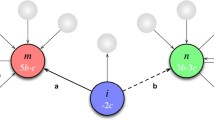Abstract
Axelrod (The evolution of cooperation, 1984) and others explain how cooperation can emerge in repeated 2-person prisoner’s dilemmas. But in public good games with anonymous contributions, we expect a breakdown of cooperation because direct reciprocity fails. However, if agents are situated in a social network determining which agents interact, and if they can influence the network, then cooperation can be a viable strategy. Social networks are modelled as graphs. Agents play public good games with their neighbours. After each game, they can terminate connections to others, and new connections are created. Cooperative agents do well because they manage to cluster with cooperators and avoid defectors. Computer simulations demonstrate that group formation and exclusion are powerful mechanisms to promote cooperation in dilemma situations. This explains why social dilemmas can often be solved if agents can choose with whom they interact.
Similar content being viewed by others
References
Alexander J.M. (2003) Random Boolean networks and evolutionary game theory. Philosophy of Science, 70: 1289–1304
Alexander J.M. (2007) The structural evolution of morality. Cambridge University Press, Cambridge
Ashlock D., Smucker M.D., Stanley E.A., Tesfatsion L. (1996) Preferential partner selection in an evolutionary study of prisoner’s dilemma. BioSystems, 37: 99–125
Axelrod R.M. (1984) The evolution of cooperation. Basic Books, New York
Axelrod R.M., Hamilton W.D. (1982) The evolution of cooperation. Science 211: 1390–1396
Bala V., Goyal S. (2000) A noncooperative model of network formation. Econometrica 68(5): 1181–1229
Barabási A.-L., Albert R. (1999) Emergence of scaling in random networks. Science 286: 509–512
Eshel I., Cavalli-Sforza L.L. (1982) Assortment of encounters and evolution of cooperativeness. PNAS 79(4): 1331–1335
Hauert C., Szabo G. (2003) Prisoner’s dilemma and public goods games in different geometries: Compulsory versus voluntary interactions. Complexity 4(4): 31–38
Hirshleifer D., Rasmusen E. (1989) Cooperation in a repeated prisoners’ dilemma with ostracism. Journal of Economic Behavior and Organization 12: 87–106
Hobbes T. (1996) Leviathan (Rev. ed.). Cambridge University Press, Cambridge (First published 1651)
Lieberman E., Hauert C., Nowak M.A. (2005) Evolutionary dynamics on graphs. Nature 433(7023): 312–316
Lindgren K., Nordahl M.G. (1994a) Cooperation and community structure in artifical ecosystems. Artificial Life 1: 15–37
Lindgren K., Nordahl M.G. (1994b) Evolutionary dynamics of spatial games. Physica D 75: 292–309
Newman M.E.J. (2003) The structure and function of complex networks. SIAM Review 45(2): 167–256
Nowak M.A., Bonhoeffer S., May R.M. (1994) Spatial games and the maintenance of cooperation. PNAS 91(11): 4877–4881
Ohtsuki H., Hauert C., Lieberman E., Nowak M.A. (2006) A simple rule for the evolution of cooperation on graphs and social networks. Nature 441: 502–505
Ohtsuki H., Nowak M.A. (2006a) Evolutionary games on cycles. Proceedings of the Royal Society B 273: 2249–2256
Ohtsuki H., Nowak M.A. (2006b) The replicator equation on graphs. Journal of Theoretical Biology 243: 86–97
Pacheco J.M., Traulsen A., Nowak M.A. (2006) Social diversity promotes the emergence of cooperation in public good games. Nature 454: 213–217
Pacheco J.M., Traulsen A., Ohtsuki H., Nowak M.A. (2008) Repeated games and direct reciprocity under active linking. Journal of Theoretical Biology 250: 723–731
Santos F.C., Pacheco J.M. (2006) A new route to the evolution of cooperation. European Society for Evolutionary Biology 19: 726–733
Santos F.C., Santos M.D., Pacheco J.M. (2008) Social diversity promotes the emergence of cooperation in public goods games. Nature 454: 213–216
Skyrms V., Pemantle R. (2000) A dynamic model of social network formation. PNAS 97(16): 9340–9346
Strogatz S. (2001) Exploring complex networks. Nature 410: 268–276
Tesfatsion, L. (1997). A trade network game with endogenous partner selection. In H. M. Amman, B. Rustem, & A. B. Whinston (Eds.), Computational approaches to economic problems (pp. 249–269). Kluwer.
Vanderschraaf P. (2006) War or peace?: A dynamical analysis of anarchy. Economics and Philosophy 22: 243–279
Vanderschraaf P. (2007) Covenants and reputations. Synthese 157: 167–195
Zimmermann M.G., J. M., Eguíluz, V. M., & San Miguel, M. (2004). Coevolution of dynamical states and interactions in dynamic networks. Physical Review E 69: 065102(R)
Author information
Authors and Affiliations
Corresponding author
Rights and permissions
About this article
Cite this article
Spiekermann, K.P. Sort out your neighbourhood. Synthese 168, 273–294 (2009). https://doi.org/10.1007/s11229-008-9424-5
Received:
Accepted:
Published:
Issue Date:
DOI: https://doi.org/10.1007/s11229-008-9424-5




